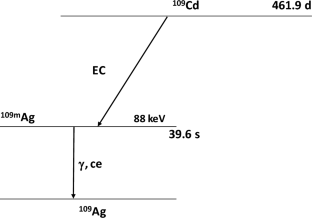Standardization of 109Cd Using CIEMAT/NIST Method and Internal Conversion Electron Counting
Abstract
109Cd is a very important radionuclide and frequently used for calibration of gamma ray spectrometers in low energy region due to its emission of 88 keV photons and long half-life of 461.9 ± 0.4 days. Due to complex decay scheme standardization of 109Cd is very challenging and was selected for international intercomparison by Bureau International des Poids et Mesures (BIPM) in 2021.109Cd decays via electron capture to the excited state of 109mAg which decays mainly with emission of conversion electrons with half-life of 39.6 s. Due to this standardization of 109Cd using conventional 4πβ-γ coincidence method is extremely difficult. Some of the methods for standardization of 109Cd were measurement of conversion electron emission rate using liquid scintillation spectrometer and CIEMAT/NIST method. BARC is the designated institute (DI) for ionizing radiation of India. In BARC, RSS, RSSD has been entrusted with the responsibilities related to activities of DI for ionizing radiation and hence develops, establishes, maintains and upgrades the primary and secondary standards for ionizing radiation quantities to provide traceability to the ionizing radiation measurements in the country. To establish the degrees of equivalence with the NMIs/DIs of other countries, BARC participated in international intercomparison of activity measurements of 109Cd (CCRI(II)-K2.Cd-109 key comparison) piloted by BIPM with support of LNE-LNHB, France. The standardization was carried out by CIEMAT/NIST efficiency tracing using 3H as a tracer and 4π liquid scintillation conversion electron measurements. The activity concentration obtained by CIEMAT/ NIST efficiency tracing has the deviation of 0.59% with respect to the value obtained using 4π liquid scintillation conversion electron measurements which is within uncertainty limits.



 求助内容:
求助内容: 应助结果提醒方式:
应助结果提醒方式:


